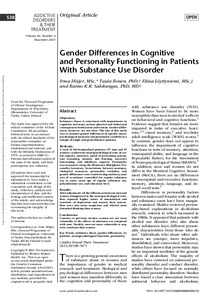Gender Differences in Cognitive and Personality Functioning in Patients With Substance Use Disorder
Löyttyniemi Eliisa; Höijer Irma; Ilonen Tuula; Salokangas Raimo K.R.
https://urn.fi/URN:NBN:fi-fe2022012710655
Tiivistelmä
Objectives:
Substance abuse is associated with impairments in cognition and many serious physical and behavioral consequences both in men and women. Gender differences, however, are not clear. The aim of this study was to examine gender differences in specific neuropsychological measures and personality variables in a sample of single and polysubstance patients.
Methods:
A total of 164 hospitalized patients—97 men and 67 women—underwent neuropsychological tests of verbal capacity, attention, speed of processing, perceptual reasoning, memory and learning, executive functioning, and inhibitory capacity. Personality was measured using the Minnesota Multiphasic Personality Inventory. Associations between neuropsychological measures, personality variables, and gender differences were studied using multiway analysis of covariance controlled for regular substance use in years, onset age of regular substance use, polysubstance use, and education level.
Results:
After adjustment, all the differences between men and women disappeared in the neuropsychological tests. Men reported higher values of somatisation and emotions of depression and anxiety than women. Men were also more suspicious and elicited more disturbed thinking than women.
Conclusions:
Contrary to previous studies, women are not more vulnerable to the effects of substance use compared with men. Notably, men are more vulnerable to negative emotions than women.
Kokoelmat
- Rinnakkaistallenteet [19207]
